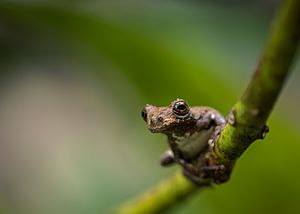Dendropsophus marmoratus facts for kids
Quick facts for kids Dendropsophus marmoratus |
|
|---|---|
 |
|
| Conservation status | |
| Scientific classification |
The Dendropsophus marmoratus, also known as the marmorea frog, is a type of frog. It belongs to the Hylidae family, which are often called tree frogs.
You can find this frog in the Amazon rainforest. It also lives in mountain forests in places like Bolivia, Brazil, Colombia, Ecuador, French Guiana, Guyana, Peru, Suriname, and Venezuela. These frogs like warm, wet lowland forests. They can also be found near temporary freshwater marshes.
The name "Marmoratus" comes from Latin. It means "marble." This name probably refers to the frog's back pattern, which looks like marble. Sadly, this frog is threatened by habitat loss. This means its natural home is disappearing.
Contents
Identifying the Marmorea Frog
It's easy to spot a marmorea frog because of its unique look.
Colors and Patterns
This is a medium-sized frog. Its body can be bronze, dark brown, green, or reddish. It often has mottled (blotchy) patterns. The membranes between its fingers are yellow-orange. Its belly is white with black dots. No other close frog species has this exact color pattern. This makes the marmorea frog easy to tell apart from other frogs living nearby.
Size
Male marmorea frogs are about 3.5 centimeters (1.4 inches) long. Females are a bit bigger, around 4.7 centimeters (1.9 inches) long. This measurement is taken from their snout (nose) to their vent (bottom).
Body Features
The frog's snout is round when you look at it from above or from the side. It has an eardrum. Its outer finger has a membrane that goes all the way to the tip. Other fingers have membranes covering about two-thirds of their length. Their toes also have membranes at the base of the tips.
Males do not have rough patches on their hands during breeding season. The skin on their back is slightly bumpy. The skin on their belly feels grainy. You might also see wavy skin folds on the outer edges of their feet, forearms, and hands.
Colors in Life
The back of the frog can be grayish-bronze or greenish-bronze. It has black, dark brown, or reddish blotches. Sometimes, there are olive-green areas on its sides. Many frogs have two large brown or reddish marks on their shoulders.
The armpit, groin, and back of the thighs are yellow-orange. The thighs might have black spots. The front of the thighs are pale yellow-green with black dots. The chin and belly are white or light yellow with black dots. The undersides of the limbs are dark gray to black. The membranes between their fingers and toes are orange at the tips and black closer to the body. Their eyes are pale gray with thin black lines.
Where They Live and What They Do
The marmorea frog lives in trees in the forest. However, when it's time to breed, they move to open areas. Many frogs are found near temporary pools or ditches filled with water. These are usually in clearings near the forest. Some frogs stay in tree branches in both new and old forests.
These frogs can live at different heights, from ground level up to 1,000 meters (about 3,300 feet) above sea level. They are found across the Amazon Basin. This includes parts of Brazil, Colombia, Ecuador, Peru, Bolivia, southern Venezuela, and the Guyanas. They are often heard singing in groups, especially in large clearings where water is present.
Frog Families
The Dendropsophus marmoratus is part of a group of frogs called the Dendropsophus marmoratus group. This group has eight different species. Only the Dendropsophus marmoratus frog is found in Ecuador. These frogs might share a special feature: bumpy skin on the edge of their lower lip.
More Fun Facts
Scientists have studied the marmorea frog's tadpoles. They have learned about their body shape, where they live, and what they eat. They also studied how the frogs make sounds.
These frogs mainly eat insects. Their favorite foods are beetles and a type of insect called orthoptera (like crickets). Some studies show they also eat a lot of ants. This might be because they have short jaws and a thin head.
Scientists have also observed that bigger male frogs are more likely to find a partner. This means size can be important when they choose who to mate with.
See also
 In Spanish: Rana marmórea para niños
In Spanish: Rana marmórea para niños


